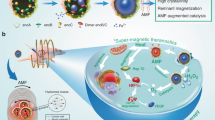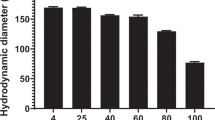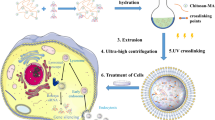Abstract
Cancer gene therapy requires a safe and effective gene delivery system. Polymer- and lipid-coated magnetic nanocrystals have been used to deliver silencing RNA, but synthesizing these magnetic vectors is difficult. Here, we show that a new nanoparticle formulation can be magnetically guided to deliver and silence genes in cells and tumours in mice. This formulation, termed LipoMag, consists of an oleic acid-coated magnetic nanocrystal core and a cationic lipid shell. When compared with the commercially available PolyMag formulation, LipoMag displayed more efficient gene silencing in 9 of 13 cell lines, and better anti-tumour effects when systemically administered to mice bearing gastric tumours. By delivering an optimized sequence of a silencing RNA that targets the epidermal growth factor receptor of tumour vessels, the intended therapeutic benefit was achieved with no evident adverse immune reaction or untoward side effects.
This is a preview of subscription content, access via your institution
Access options
Subscribe to this journal
Receive 12 print issues and online access
$259.00 per year
only $21.58 per issue
Buy this article
- Purchase on Springer Link
- Instant access to full article PDF
Prices may be subject to local taxes which are calculated during checkout






Similar content being viewed by others
References
Kato, H. et al. (ed.) Cancer Statistics in Japan (Foundation for Promotion of Cancer Research, 2008).
Fire, A. et al. Potent and specific genetic interference by double-stranded RNA in Caenorhabditis elegans. Nature 391, 806–811 (1998).
Li, C. X. et al. Delivery of RNA interference. Cell Cycle 5, 2103–2109 (2006).
Toub, N., Malvy, C., Fattal, E. & Couvreur, P. Innovative nanotechnologies for the delivery of oligonucleotides and siRNA. Biomed. Pharmacother. 60, 607–620 (2006).
Scherer, F. et al. Magnetofection: enhancing and targeting gene delivery by magnetic force in vitro and in vivo. Gene. Ther. 9, 102–109 (2002).
Huth, S. et al. Insights into the mechanism of magnetofection using PEI-based magnetofectins for gene transfer. J. Gene Med. 6, 923–936 (2004).
Kamau, S. W. et al. Enhancement of the efficiency of non-viral gene delivery by application of pulsed magnetic field. Nucleic Acid Res. 34, e40 (2006).
Plank, C. et al. The magnetofection method: using magnetic force to enhance gene delivery. Biol. Chem. 384, 737–747 (2003).
Neuberger, T., Schopf, B., Hofmann, H., Hoffmann, M. & von Rechenberg, B. Superparamagnetic nanoparticles for biomedical applications: possibilities and limitations of a new drug delivery system. J. Magn. Magn. Mater. 293, 483–496 (2005).
Harris, L. A. et al. Magnetite nanoparticle dispersions stabilized with triblock copolymers. Chem. Mater. 15, 1367–1377 (2003).
Krotz, F. et al. Magnetofection: a highly efficient tool for antisense oligonucleotide delivery in vitro and in vivo. Mol. Ther. 7, 700–710 (2003).
Lawrie, A. et al. Ultrasound enhances reporter gene expression after transfection of vascular cells in vitro. Circulation 99, 2617–2620 (1999).
Berg, K. et al. Photochemical internalization: a novel technology for delivery of macromolecules into cytosol. Cancer Res. 59, 1180–1183 (1999).
Namiki, Y. et al. Enhanced photodynamic anti-tumor effect on gastric cancer by a novel photosensitive stealth liposome. Pharmacol. Res. 50, 65–76 (2004).
De Cuyper, M. & Joniau, M. Mechanistic aspects of the adsorption of phospholipids onto lauric acid stabilized magnetite nanocolloids. Langmuir 7, 647–652 (1991).
Chandler, D. Interfaces and the driving force of hydrophobic assembly. Nature 437, 640–647 (2005).
Kauzmann, W. Some forces in the interpretation of protein denaturation. Adv. Prot. Chem. 14, 1–63 (1959).
Rosenweig, R. E. Magnetic fluids. Int. Sci. Tech. 55, 48–56 (1966).
Reimers, G. W. & Khalafalla, S. E. Production of magnetic fluids by peptization techniques. U.S. patent 3,843,540 (1974).
Hirota, Y., Suzuki, H. & Tsuda, S. Magnetic fluid having an improved chemical stability by surface modifying treatment. Proceedings of the Japan Society of Magnetic Fluid Research Annual Conference 27–29 (Tohoku University, Sendai, Japan, 2003).
Namiki, Y. et al. Preclinical study of a ‘tailor-made’ combination of NK4-expressing gene therapy and gefitinib (ZD1839, IressaTM) for disseminated peritoneal scirrhous gastric cancer. Int. J. Cancer 118, 1545–1555 (2006).
Patel, P. C., Giljohann, D. A., Seferos, D. S. & Mirkin, C. A. Peptide antisense nanoparticles. Proc. Natl Acad. Sci. USA 105, 17222–17226 (2008).
Cho, S. W. et al. Delivery of small interfering RNA for inhibition of endothelial cell apoptosis by hypoxia and serum deprivation. Biochem. Biophys. Res. Commun. 376, 158–163 (2008).
Jangi, S. M. et al. Terfenadine-induced apoptosis in human melanoma cells is mediated through Ca2+ homeostasis modulation and tyrosine kinase activity, independently of H1 histamine receptors. Carcinogenesis 29, 500–509 (2008).
Folkman, J. & Shing, Y. Angiogenesis. J. Biol. Chem. 267, 10931–10934 (1992).
Amin, D. N., Hida, K., Bielenberg, D. R. & Klaqsbrun, M. Tumor endothelial cells express epidermal growth factor receptor (EGFR) but not ErbB3 and are responsive to EGF and to kinase inhibitors. Cancer Res. 66, 2173–2180 (2006).
Judge, A. D., Bola, G., Lee, A. C. & MacLachlan, I. Design of noninflammatory synthetic siRNA mediating potent gene silencing in vivo. Mol. Ther. 13, 494–505 (2006).
Robbins, M. et al. Misinterpreting the therapeutic effects of small interfering RNA caused by immune stimulation. Hum. Gene Ther. 19, 991–999 (2008).
Elbashir, S. M., Martinez, J., Patkaniowska, A., Lendeckel, W. & Tuschl, T. Functional anatomy of siRNAs for mediating efficient RNAi in Drosophila melanogaster embryo lysate. EMBO J. 20, 6877–6888 (2001).
Soutschek J. et al. Therapeutic silencing of an endogenous gene by systemic administration of modified siRNAs. Nature 432, 173–178 (2004).
Serikawa, T., Suzuki, N., Kikuchi, H., Tanaka, K. & Kitagawa, T. A new cationic liposome for efficient gene delivery with serum into cultured human cells: a quantitative analysis using two independent fluorescent probes. Biochim. Biophys. Acta 1467, 419–430 (2000).
Takahashi, T., Namiki, Y. & Ohno, T. Induction of the suicide HSVtk gene by activation of the Egr-1 promoter with radioisotopes. Hum. Gene Ther. 8, 827–833 (1997).
Namiki, Y., Takahashi, T. & Ohno, T. Gene transduction for disseminated intraperitoneal tumor using cationic liposomes containing non-histone chromatin proteins. Gene Ther. 5, 240–246 (1998).
Hida, K., Hida, Y. & Shindoh, M. Understanding tumor endothelial cell abnormalities to develop ideal anti-angiogenic therapies. Cancer Sci. 99, 459–466 (2008).
Acknowledgements
We dedicate this study to the late T. Terada for his fight against cancer, which came too early in his life. HSC39, HSC43 and HSC45 were kindly donated by K. Yanagihara. OCUM-2MD3 was kindly donated by M. Yashiro. This work was supported by an Industrial Technology Research Grant, Program 08C46049a (2008), from the New Energy and Industrial Technology Development Organization (NEDO) of Japan, the Futaba Electronics Memorial Foundation (2008), the Takeda Science Foundation (2007) and the Tsuchiya Foundation (2006).
Author information
Authors and Affiliations
Contributions
Y.N. and T.N. conceived and designed the experiments. Y.N., H.Y., A.T., K.N., S.K, M.M., Y.M. and Y.Y. performed the experiments. Y.N., H.Y. and Y.I. co-wrote the paper. T.N. performed the statistical analysis. S.Y. and H.K. supplied the clinical specimens from gastric cancer patients. S.H., K.F. and N.T. supervised the project.
Corresponding author
Supplementary information
Supplementary information
Supplementary information (PDF 4827 kb)
Rights and permissions
About this article
Cite this article
Namiki, Y., Namiki, T., Yoshida, H. et al. A novel magnetic crystal–lipid nanostructure for magnetically guided in vivo gene delivery. Nature Nanotech 4, 598–606 (2009). https://doi.org/10.1038/nnano.2009.202
Received:
Accepted:
Published:
Issue Date:
DOI: https://doi.org/10.1038/nnano.2009.202
This article is cited by
-
Research trends on nanomaterials in gastric cancer: a bibliometric analysis from 2004 to 2023
Journal of Nanobiotechnology (2023)
-
Controlled drug delivery vehicles for cancer treatment and their performance
Signal Transduction and Targeted Therapy (2018)
-
Magnetic nanoparticles based cancer therapy: current status and applications
Science China Life Sciences (2018)
-
A novel targeted angiogenesis technique using VEGF conjugated magnetic nanoparticles and in-vitro endothelial barrier crossing
BMC Cardiovascular Disorders (2017)
-
Magnetic forces enable controlled drug delivery by disrupting endothelial cell-cell junctions
Nature Communications (2017)



